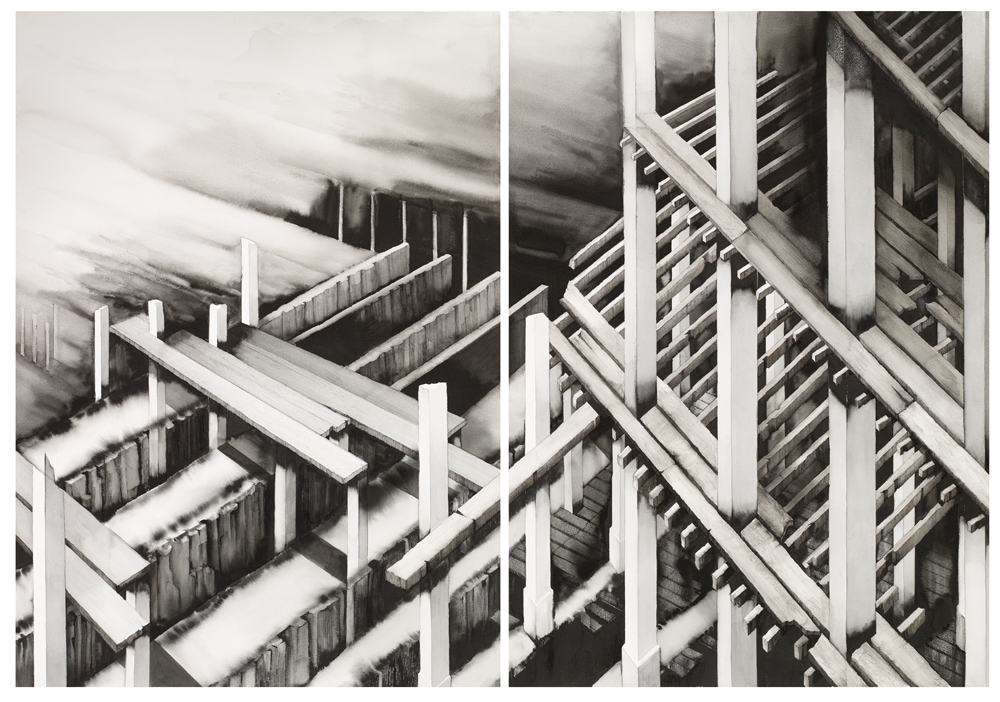Camp Covid , 2020 - Deanna Petherbridge
Deanna Petherbridge was one of those people who you could not avoid if you were interested in drawing. I met her several times and she always carried herself with great dignity and she provided a deep pool of intellectual resources from which you could tap into and draw from many different streams of thinking about drawing. I was therefore saddened to hear that she had recently died.
I first came across her large pen and ink drawings in the 1980s and was impressed by her conviction that drawing was something that could carry serious ideas. At that time drawing was still seen as an adjunct to painting or sculpture, something you did whilst you were thinking about how to compose an image or how to fit components together and it was in the world of the sketchbook or notebook that drawing belonged. This together with the demise of objective drawing as an essential tool of the artist, meant that if you drew, you were 'just' someone who did 'works on paper'. This of course meant that very few drawings were ever seen as being worth anything; unless of course they were by Leonardo or Michelangelo and oil painting seemed to reign supreme as the only form of art serious collectors wanted to invest in. As someone raised on a diet of conceptual art, I was always attracted to drawing as a form of thinking tool and often felt that too many paintings were empty gestures or examples of poor or impoverished thinking. I would often prefer a 3 by 3 inch drawn note on a scrap of paper to a 6 foot by 8 foot oil painting on linen canvas.
Deanna Petherbridge was one of a group of artists who took drawing seriously and she not only took on drawing as a serious activity in its own right, she also began to write about drawing and its effects, eventually producing the classic textbook on drawing, 'The Primacy of Drawing: Histories and Theories of Practice' (2010) and several essays and commentaries about drawing for the architecturally focused publication 'Drawing Matter'. Her own drawings use imagined architectural imagery as a metaphorical means to deal with complex subject matter about social and political issues and she strongly believed that drawing could deal with and carry the weight of big issues, just as much as any other art form.
Migration 1 , 2018 - Deanna Petherbridge
Petherbridge used images of architecture and mechanical forms often composed as metaphors for the human condition. Her representations of transparency and of other lighting conditions, were often contrasted with deep shadows; her imagery moving between abstraction and representation, in order to create dream-like worlds and sustained visual narratives.
View from Hotel Pandemia, 2020 - Deanna Petherbridge
Never afraid of advancing the work of other artists who drew, she helped myself to widen the pool of practitioners that I was aware of, in particular introducing me to the work of the Australian artist Joy Hester.
Joy Hester
So goodby Deanna, another person that I knew, who is now sitting on the other side of that thin membrane that stretches between life and death. I have recently had to seriously rethink what I am doing in both art making and in how I have been living my everyday life. I have decided to unravel how my past life still impacts on my present one and in doing so I have also had to consider in much more depth, the impact of day to day decisions on possible futures. This process has of course had to include a deeper awareness of mortality, not because I have some sort of immediate concerns about my health, but simply because a full awareness of life is impossible without an acceptance of its coming to an end at some point.
Deanna Petherbridge: The Destruction of Palmyra, 2017. Pen and ink on paper, Triptych.
Deanna was slightly older than myself when she drew 'The Destruction of Palmyra', an image that is a meditation on the destruction by Islamic fundamentalist groups of ancient artefacts found in archeological sites. Whether these attacks on culture are made by religious fanatics or far right fundamentalists doesn't really matter, what does matter is that Petherbridge's drawings remind us that artistic freedom is a hard won thing and that it is so easily lost. Petherbridge's life was centred on a belief in the power of images to help us see what we sometimes don't see and in that she leaves a powerful legacy, I hope that in another hundred years what she stood for will still be something that makes sense and is recognisable as being worthwhile.
John Berger put his take on mortality slightly differently. When remembering the comedian Harry Champion, Berger would quote his catchphrase, "Life is a very hard thing. You never come out of it alive".
An online catalogue of the Step and Stair Exhibition at the Art Space Gallery: A memory of the only time I exhibited in an exhibition alongside Deanna Petherbridge






No comments:
Post a Comment